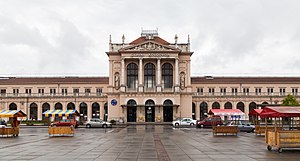Glavni kolodvor | |||||||||||
|---|---|---|---|---|---|---|---|---|---|---|---|
 Main entrance | |||||||||||
| General information | |||||||||||
| Location | Trg kralja Tomislava 12, Zagreb Croatia | ||||||||||
| Coordinates | 45°48′17″N 15°58′44″E / 45.80472°N 15.97889°E | ||||||||||
| Line(s) | |||||||||||
| Platforms | 7 | ||||||||||
| Tracks | 9 | ||||||||||
| History | |||||||||||
| Opened | 1892 | ||||||||||
| Rebuilt | 1987 | ||||||||||
| Electrified | 1970 (25 kV 50 Hz AC to Belgrade and 3 kV DC to Rijeka) 1985 (25 kV 50 Hz AC to Rijeka) | ||||||||||
| Services | |||||||||||
| |||||||||||
| Type | Cultural | ||||||||||
Zagreb Glavni kolodvor (Croatian for Zagreb main station[1]) is the main railway station in Zagreb, Croatia.[2] Located 1 km (0.62 mi) south of the city's main square,[1] it is the largest station in Croatia and the main hub of the Croatian Railways network.
History
[edit]An 1890 act of the Royal Hungarian Government authorised the building of the main station and maintenance shop in Zagreb.[3] Construction of the 186.5 m (612 ft) long neoclassical style station building began in 1891[4] and was overseen by Hungarian architect Ferenc Pfaff.[1] Sculptural works were undertaken by the Hungarian sculptor Vilim Marschenko.[3] The station opened on 1 July 1892.[3] It is one of the largest public buildings built in 19th century Zagreb.[5]
Reconstruction works were undertaken in 1986–87 (just before the 1987 Summer Universiade) and again in 2006.[6]
International Lines
[edit]- EC 158/159 CROATIA: Zagreb – Graz – Vienna Hbf (through Maribor)
- 200/201 AGRAM: Zagreb – Budapest Déli (through Koprivnica)
- 204/205 GRADEC: Zagreb – Budapest Déli (through Koprivnica)
- 210/211 SAVA: Villach – Zagreb – Vinkovci
- EC 212/213 MIMARA: Zagreb – Villach (– Frankfurt Hbf)
- 412/413: Zagreb – Belgrade
- IC 310/311: Zagreb – Villach
- 414/415: Belgrade – Zagreb – Schwarzach im Pongau (- Zürich HB)
- EN 498/499 LISINSKI: Zagreb – München Hbf.
Public transport
[edit]Directly in front of the main railway station, there is a stop for Zagreb tram lines 2, 4, 6, 9 and 13. They are operated by the Zagreb Electric Tram (ZET). With lines 2 and 6 you can reach the Bus station, which is three stops away and from which many buses travel to larger and smaller cities in Croatia and neighboring countries.
Train Disaster
[edit]On 30 August 1974, the station was the site of the deadliest train accident in Yugoslavia at the time, with 153 people dead. The incident occurred when a train from Belgrade headed for Dortmund derailed at the entrance of the station.[7][8]
Gallery
[edit]-
Interior
-
A view of the platforms from the east
-
HŽ series 6111 inter-urban train at a platform
-
Statue of King Tomislav in front of the railway station
-
Details of statues of Neoclassicism
-
Railway platform view
See also
[edit]References
[edit]- ^ a b c Piers Letcher (March 2013). Croatia. Bradt Travel Guides. p. 81.
- ^ Mark Smith. "Visiting the city of Zagreb". Seat61.com.
- ^ a b c "The main railroad station house at Zagreb". Hrvatska pošta.
- ^ "Prvi vlak pristaje na Južnom kolodvoru".
- ^ Damjanovic, Dragan. "In the Shadow of Budapest (and Vienna) – Architecture and Urban Development of Zagreb in the Late 19th and Early 20th Centuries. // Zeitschrift für Ostmitteleuropa-Forschung / Journal of East Central European Studies. 67 (2018), 4; 522-551". Zeitschrift für Ostmitteleuropa-Forschung / Journal of East Central European Studies.
- ^ "Trg kralja Tomislava". Vjesnik (in Croatian). 1999-08-03. Archived from the original on 2009-03-26.
- ^ "Najveća željeznička nesreća u hrvatskoj povijesti – Crna kronika – Hrvatska – Dalje.com". 2015-04-03. Archived from the original on 2015-04-03. Retrieved 2023-12-03.
- ^ Malcolm W. Browne (1974-09-01). "Yugoslays Mourn 150 Killed in Zagreb Train Crash". The New York Times. ISSN 0362-4331. Retrieved 2023-12-03.








